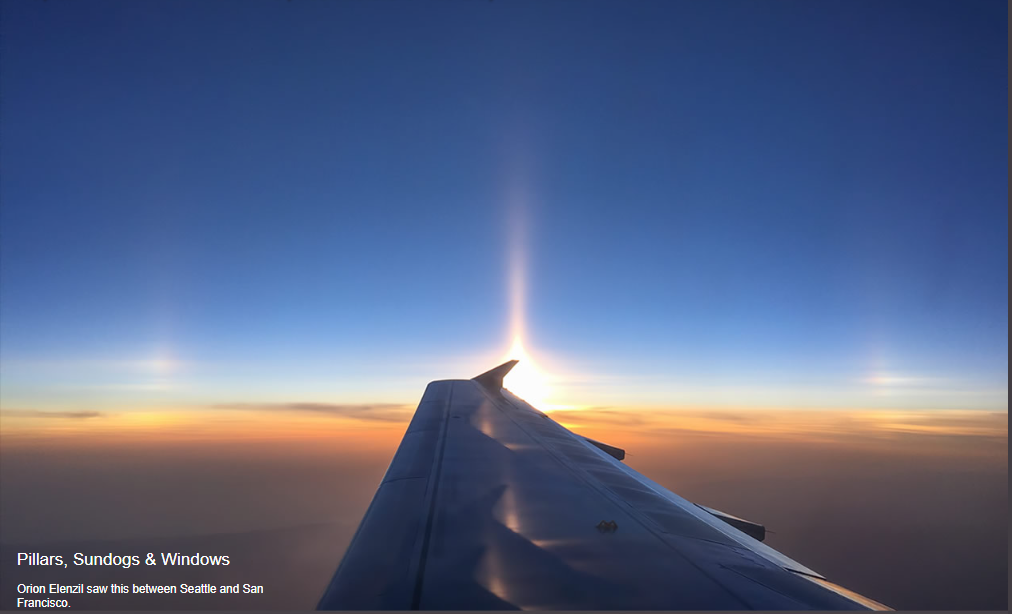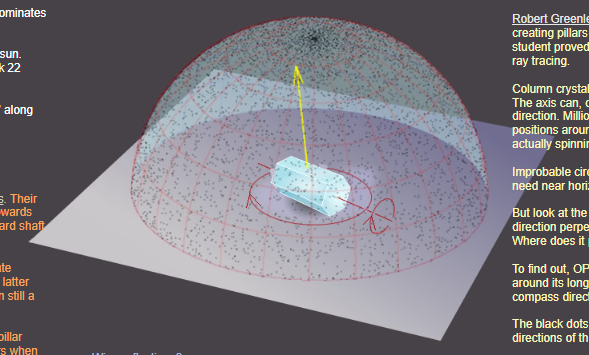Pillars, Sundogs & Aircraft Windows - OPOD
Pillars, Sundogs & Aircraft Windows - A Fascinating Phenomenon in the Sky
When gazing at the sky, we often encounter mesmerizing atmospheric optics phenomena that leave us in awe. One such spectacle is the combination of pillars, sundogs, and aircraft windows. These enchanting optical illusions can be observed in various locations, captivating both amateur skywatchers and seasoned professionals.
The Dominance of Sun Pillars and Prismatic Sundogs
In a stunning photograph captured by Orion Elenzil between Seattle and San Francisco, a remarkably tall and bright sun pillar takes center stage in the high-altitude sky. Sun pillars occur when sunlight interacts with ice crystals in the atmosphere, creating an illusion of a vertical shaft of light extending upwards from the sun. Accompanying this pillar are prismatic sundogs, which are fragments of a 22-degree halo caused by the refraction of sunlight through ice crystals. These sundogs appear as extensions of the low sun, adding to the captivating display.
The Pioneering Work of Robert Greenler
The scientific understanding behind these atmospheric phenomena was significantly advanced by the pioneering work of Robert Greenler in the early 1970s. Greenler proposed that column crystals, rather than plate crystals, were responsible for creating sun pillars. Alongside his student, he proved this concept through computer ray tracing, revolutionizing our comprehension of these optical marvels.
The Intricate Nature of Column Crystals
Column crystals, with their elongated shape and horizontal orientation, play a crucial role in the formation of sun pillars. These crystals can rotate freely around their long axis, mimicking the appearance of spinning. Despite seemingly improbable circumstances, near-horizontal facets on these crystals mirror the sun and create the illusion of a vertical beam of light.
To understand this phenomenon better, computer simulations were conducted. The results were surprising: the directions of the yellow arrow on the crystal facets did not spread randomly across the sky sphere. Instead, they clustered strongly at the north pole, indicating that the crystal side facets spend a significant amount of time nearly horizontal. This alignment of the crystal facets provides the ideal conditions for the creation of sun pillars.
The Influence of Plate and Column Crystals
While wobbly plate crystals predominantly form sun pillars, it is possible that column crystals played a role in the particular instance captured by Orion Elenzil. Plate crystals, with their near-horizontal facets, reflect sunlight towards the observer, creating the illusion of an upward shaft of light. However, if there were not enough plate crystals present, column crystals could have contributed to the formation of the towering pillar observed in the photograph. These horizontal columns are known to generate tall pillars when the sun is above the horizon.
The Enigmatic Wing Reflections
Upon closer examination of the photograph, one may notice the presence of reflections along the aircraft wing. These reflections exhibit the same pillar and bright horizon seen in the sky. Surprisingly, these illusions are not created by the wing surface itself but by reflections occurring within the triple aircraft window. Double and triple glazed windows can give rise to numerous optical illusions, adding to the wonderment of atmospheric optics.
In conclusion, the combination of pillars, sundogs, and aircraft windows presents a captivating display of atmospheric optics phenomena. Through the pioneering work of scientists like Robert Greenler and advancements in computer simulations, we have gained valuable insights into the formation of sun pillars and the role of different types of ice crystals. As we continue to explore and marvel at the mysteries of our atmosphere, let us never cease to be amazed by the beauty that lies above us.

Pillars, Sundogs & Windows
Orion Elenzil saw this between Seattle and San Francisco.
A very tall (17�) and bright sun pillar dominates the high altitude sky.
Prismatic sundogs accompany the low sun. Their upwards �extensions� are weak 22 degree halo fragments.
Something is odd about the 'reflections' along the wing.
Image ©Orion Elenzil, shown with permissionRobert Greenler first conceived of column crystals creating pillars in the early 1970s. He and his student proved the idea with their pioneer computer ray tracing.
Column crystals drift with their long axis horizontal. The axis can, of course, point in any compass direction. Millions of crystals have all rotation positions around the long axis just as if they were actually spinning.
Improbable circumstances for creating a pillar? We need near horizontal facets to mirror the sun.
But look at the diagram. The yellow arrow is the direction perpendicular to a crystal prism face. Where does it point?
To find out, OPOD's computer spun a crystal around its long axis while also pointing it in random compass directions.
The black dots on the sky sphere mark the directions of the yellow arrow.
Surprisingly, the dots do not spread randomly over the sphere. They cluster strongly at the north pole. The crystal side facets spend much of their time nearly horizontal.
Just what we need to create a sun pillar!
Wobbly plate crystals make most pillars. Their near horizontal facets reflect the sun towards the eye to create the illusion of an upward shaft of light.
But perhaps there were not enough plate crystals. Plates make sundogs and the latter are weak. The pillar is also tall for a sun still a few degrees above the horizon.
Column crystals could have made the pillar rather than plates. They make tall pillars when the sun is above the horizon.
How can horizontal columns make a pillar when their facets tilt in all directions? See right...

Wing reflections?
The pillar and bright horizon appear three times along the wing. They are created by reflections inside the triple aircraft window rather than by the wing surface. Double and triple glazed windows create many illusions.
Note: this article has been automatically converted from the old site and may not appear as intended. You can find the original article here.
Reference Atmospheric Optics
If you use any of the definitions, information, or data presented on Atmospheric Optics, please copy the link or reference below to properly credit us as the reference source. Thank you!
-
<a href="https://atoptics.co.uk/blog/pillars-sundogs-aircraft-windows-opod/">Pillars, Sundogs & Aircraft Windows - OPOD</a>
-
"Pillars, Sundogs & Aircraft Windows - OPOD". Atmospheric Optics. Accessed on November 15, 2024. https://atoptics.co.uk/blog/pillars-sundogs-aircraft-windows-opod/.
-
"Pillars, Sundogs & Aircraft Windows - OPOD". Atmospheric Optics, https://atoptics.co.uk/blog/pillars-sundogs-aircraft-windows-opod/. Accessed 15 November, 2024
-
Pillars, Sundogs & Aircraft Windows - OPOD. Atmospheric Optics. Retrieved from https://atoptics.co.uk/blog/pillars-sundogs-aircraft-windows-opod/.